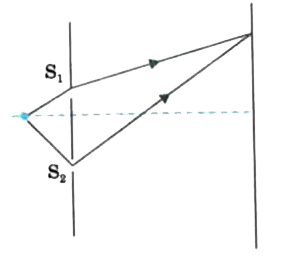In Young's double-slit experiment, one of the slit is wider than other so that the amplitude of the light from one slit is double of that from other slit. If Im be the maximum intensity, the resultant intensity I when they interfere at phase difference ϕ is given by:
Im9(1+8cos2(θ)2)
Im9(4+5cos2ϕ)
Im3(1+2cos2(ϕ)2)
Im5(1+3cos2(ϕ)2)
The correct Answer is:A
Let I1andI2 be intensities which are coming from slits S1andS2
The resultant intensity
∴I=I1+I2+2√I1I2cosθ
I2=K(2A)2
=4KA2
∴I2=4I1

Im=I1+I2+2√I1I2cos0∘
=I1+4I1+2√4I21
=I1+4I1+2×2I1
Im=9I1⇒I1=Im9⇒I2=4Im9
I=Im9+4Im9+2√Im9×4Im9cosθ
=Im9+4Im9+2√4I2m81cosθ
=Im9(5+4cosθ)=Im9(1+8cos2θ/2)
Topper's Solved these Questions
- WAVE OPTICALBOOK - MODERN PUBLICATIONCHAPTER - WAVE OPTICALEXERCISE - OBJECTIVE TYPE QUESTIONS (JEE (ADVANCED) FOR IIT ENTRANCE)
6 Videos
- WAVE OPTICALBOOK - MODERN PUBLICATIONCHAPTER - WAVE OPTICALEXERCISE - OBJECTIVE TYPE QUESTIONS (C. MULTIPLE CHOICE QUESTIONS)
14 Videos
- WAVE OPTICALBOOK - MODERN PUBLICATIONCHAPTER - WAVE OPTICALEXERCISE - OBJECTIVE TYPE QUESTIONS (B. MULTIPLE CHOICE QUESTIONS) -AIPMT/NEET & OTHER STATE BOARDS FOR MEDICAL ENTRANCE
10 Videos
- SEMICONDUCTOR ELECTRONICS METERIALS DEVICES AND SIMPLE CIRCUITS BOOK - MODERN PUBLICATIONCHAPTER - SEMICONDUCTOR ELECTRONICS METERIALS DEVICES AND SIMPLE CIRCUITS EXERCISE - CHAPTER PRACTICE TEST FOR BOARD EXAMINATION
12 Videos
Similar Questions
In Young's double slit experiment, one of the slit is wider than other, so that amplitude of the light from one slit is double of that from other slit. If Im be the maximum intensity, the resultant intensity I when they interfere at phase difference ϕ is given by:
View SolutionIn Young's double slit experiment, if one of the slit is closed fully, then in the interference pattern
View Solution
Knowledge Check
In Young's double slit experiment, one of the slit is wider than other, so that amplitude of the light from one slit is double of that from other slit. If Im be the maximum intensity, the resultant intensity I when they interfere at phase difference ϕ is given by:
AIm9(4+5cosϕ)BIm3(1+2cos2(ϕ2)CIm5(1+4cos2(ϕ2)DIm9(1+8cos2(ϕ2)In Young's double slit experiment, one of the slit is wider than other, so that amplitude of the light from one slit is double of that from other slit. If Im be the maximum intensity, the resultant intensity I when they interfere at phase difference ϕ is given by:
AIm3(1+2cos2ϕ2)BIm5(1+4cos2ϕ2)CIm9(1+8cos2ϕ2)DIm9(8+cos2ϕ2)In Young’s double slit experiment, one of the slits is so painted that intensity of light emitted from it is half of that of the light emitted from other slit. Then :
Afringe system will disappearBbright fringes will become brighter and dark fringes will be darkerCboth bright and dark fringes will become darkerDdark fringes will become less dark and bright fringes will become less bright
The width of one of the two slits in a Young's double slit experiment is double of the other slit. Assuming that the amplitude of the light coming from a slit is proportional to the slit width, find the ratio of the maximum to the minimum intensity in the interference pattern.
View SolutionThe width of one of the two slits in a Young's double slit experiment is double of the other slit. Assuming that the amplitude of the light coming from a slit is proportional to the slit width, find the ratio of the maximum to the minimum intensity in the interference pattern.
View SolutionThe width of one of the two slits in a Young's double slit experiment is double of the other slit. Assuming that the amplitude of the light coming from a slit is proportional to the slit width, find the ratio of the maximum to the minimum intensity in the interference pattern.
View SolutionIn Young's double slit experiment, if one of the slit is closed fully, then in the interference pattern
View SolutionIn a Young's double slit experiment, the width of the one of the slit is three times the other slit. The amplitude of the light coming from a slit is proportional to the slit-width. Find the ratio of the maximum to the minimum intensity in the interference pattern.
View Solution
